Published
on 30
Jun 2016
|
All rights reserved.
|
|
|
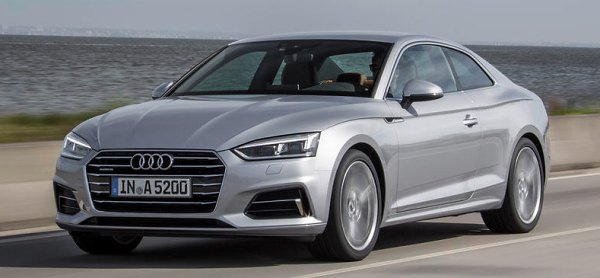
|
|
New
A5 is a competent Autobahn cruiser but not the car you would choose to
attack back roads...
|
|
The
first generation Audi A5 Coupe lasted for 9 long years but few people
found it memorable. It was neither exciting to drive nor to look, which
is to say Audi used to overstate its beauty. It might have a waist line
sexier than what we used to see on German coupes, but the rest of the
car remained more Germanic restrained than Italian emotional. Certainly
no Alfa Romeo or Maserati-sexy. Now the A5 Coupe is finally renewed.
Surprisingly, its shape looks much the same as before. That flowing
waist line
remains, as are the proportion and window openings. What Audi changed
are the details, such as crisper crease lines, edgier headlamps and the
new hexagonal front grille. The latter gets slimmer, wider and mounted
lower. The bonnet now curves more dramatically downward to meet the
grille. Frankly, these edgy elements do not gel very well with the
harmonious shape, so they just serve to look different rather than to
improve the aesthetic. I would be surprised if such design could last
more than 5 years, let alone matching the lifespan of its predecessor.
One thing the new shape does improve is aerodynamics, which is a
surprise considering the edgy elements. Its coefficient of drag drops
to 0.25, beating even Mercedes C-class Coupe (0.26) thus it is the very
best of the class. Audi doesn’t talk a lot about aerodynamic
development, but it quietly leapfrogs Mercedes.
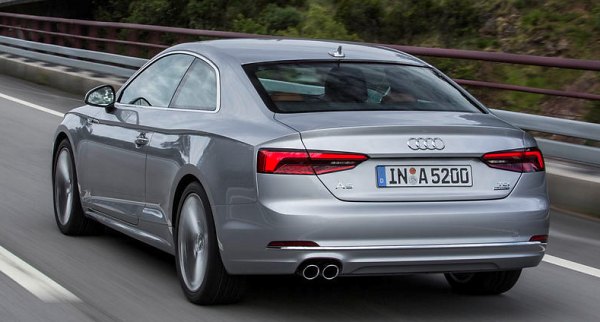
|
|
Engine
by engine, the A5 Coupe is no quicker than its 4-door sedan sister.
|
|
Aerodynamics helps
fuel efficiency, so does a lighter chassis and body. As you have
predicted, the new A5 is once again built on the A4 platform – this
time the lightweight MLB Evo. It uses a lot of high-strength steel and
some aluminum parts – such as crash beams, front suspension tower
brackets and suspension components – to save weight. The whole car is
60 kg lighter than its predecessor, pretty good considering its
wheelbase is stretched by 12 mm and overall length grows 40 mm. Compare
with A4, its wheelbase is 56 mm shorter, while front and rear tracks
are slightly wider. Disappointingly, losing 2 doors and a couple
of inches in wheelbase save only 10 to 15 kilograms, so engine by
engine, the A5 Coupe is no quicker than its 4-door sedan sister.
The suspension is carried over from the A4, although it is stiffened
slightly. Both the front and rear
wheels ride on 5-link suspension with optional adaptive damping. Other
performance features are shared with the A4 as well, such as active
rear differential and (active variable-ratio) Dynamic Steering. The
former is especially useful to cure the car’s inherent imbalance. It
goes without saying the MLB Evo platform still has the engine mounted
longitudinally north of the front axle, so it has no hope to match BMW
or Jaguar for static balance. Even the use of Quattro system doesn’t
help much in this respect. Lower power models employ the new
fuel-saving Quattro
Ultra system, which uses a multi-plate clutch to
engage the rear axle only if more traction is required. Higher power
models, such as the top 3.0 TDI and S5, employ Torsen C center
differential for a normal torque split of 40:60 front to rear. In
extreme cases this can be varied to at most 30:70 or 85:15, but you
can't always get the desired bias because the Torsen is a pure
mechanical and passive device.

|
|
MLB
Evo platform still has the engine mounted longitudinally north of the
front axle, so it has no hope to match BMW or Jaguar for static balance.
|
|
As
the coupe is mechanically so close to the A4, it is not a surprise to
see it drives with a similar manner, i.e. more about refinement than
excitement. Compared with the last generation, its ride quality is a
huge improvement, dealing well with most surfaces except the bumpiest.
Noise suppression is also good. On the downside, the steering is again
vague. Response of the optional Dynamic Steering is still inconsistent
and unpredictable (Audi and BMW should have abandoned active steering
for a mechanical variable-ratio rack like Mercedes-AMG). Handling is
more predictable and secured, but neither the front-wheel-drive models
nor
Quattro cars can match the rear-drive BMW or Mercedes for turn-in
response, throttle adjustability
and driver engagement. This means the A5 is a competent Autobahn
cruiser but not the car you would choose to attack back roads, because
it won’t put smile on your face.
Powertrain is a similar story. The 190 hp 2.0TFSI Miller-cycle, 252 hp
2.0TFSI and 218 hp 3.0TDI V6 are all efficient and civilized engines
but not powerful or tuneful enough to raise your pulse. Best of the
bunch is the 286 hp 3.0 TDI diesel V6, which is strong, flexible and
impossibly refined for a diesel engine. It gets from rest to 60 mph in
only 5 seconds, although you might not feel so fast as the exhaust note
is subdued. Unfortunately, the 8-speed Tiptronic automatic has a poor
calibration, failing to downchange as quickly as you want in tighter
turns. It is not the best application of the ZF auto.

|
|
It
breathes a strong smell of luxury that you normally get in a class or
two above...
|
|
The best thing is
the cabin. Although the whole dashboard comes straight from A4, it is
stylish and built with class-leading quality. It breathes a strong
smell of luxury that you normally get in a class or two above, making
BMW 4-Series feel cheap in comparison. With “virtual cockpit”
instrument display opted, it also feels incredibly advanced and
sophisticated. The cabin is not too spacious, but the stretched
wheelbase does improve rear legroom a little, making it more tolerable
to those shorter than 6 feet. That said, rear headroom remains a
challenge. Access to the rear seats is also quite difficult. Further
back, the boot has a class-leading volume of 465 liters and is well
shaped to handle large baggage. The rear seat back is now
40/20/40-split to give easy access to the boot.
However, all these fail to lift the A5 Coupe above the level of A4. As
a coupe, its styling is a bit conservative, and its powertrain and
chassis do not feel sporty enough to justify the higher prices and loss
of practicality.
|
Verdict:    |
Published
on 30
Jun 2016
|
All rights reserved.
|
|
Audi S5
|
|
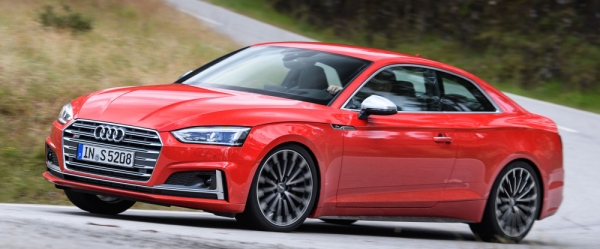 |
|
The
switch from supercharging to turbocharging does not rob the S5 any
response or flexbility, but its soundtrack gets muted.
|
|
Audi no longer
offers a petrol V6 to A5. If you want one, you have to upgrade to the
S5. Like the recent S4, it is powered by a brand-new single-turbo
3.0-liter V6 good for 354 horsepower, and a remarkable 369 pound-foot
of torque from merely 1370 rpm. The 90-degree V6 has its twin-scroll
turbo mounted inside the V-valley for shorter exhaust piping hence
reduced turbo lag. It is also capable to run at Miller-cycle combustion
mode on part load to save fuel. Compared with BMW 440i, it is more
powerful yet more frugal. 0-60 mph takes 4.5 seconds, a couple of
tenths quicker than a 440i xDrive. That equals to the slightly more
powerful Mercedes-AMG C43 4matic Coupe. Frankly, performance of these
cars is too close to separate, so we had better to see how they feel
subjectively on the road.
The new 3.0TFSI engine is responsive, flexible and refined for sure,
but it lacks aural appeal and an enthusiasm at the top end to inspire
keen drivers. Comparatively, the BMW straight six is more eager to spin
to 7000 rpm while Mercedes’ V6 sounds far angrier on full throttle and
overrun. The Audi engine leaves you a feeling that it is just too
civilized and efficient. It just wants to do the job and no more. Like
many Audi engines, it is effective but rather soulless.
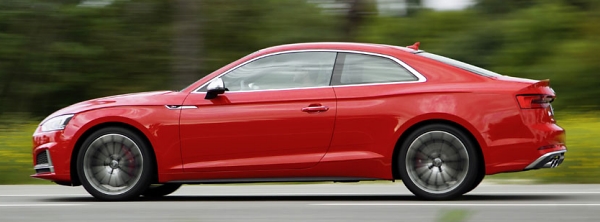 |
|
Replacing
the DCT with a torque converter automatic is a regress, especially with
a calibration so flawed.
|
|
The 8-speed Tiptronic gearbox is again a disappointment. In comfort
mode it is refined enough, but in dynamic mode when you are pushing the
car in the twisty, you will find it is reluctant to downshift. The
gearshift is also surprisingly jerky in such situations. Audi used to
equip the old S5 with a good S-tronic twin-clutch box. Replacing it
with this torque converter automatic is a regress, especially with a
calibration so flawed.
The S5’s suspension is stiffened and lowered by 23 mm compared with
lesser A5s. When rides on optional 255/35R19 tires, it provides strong
grip and traction yet ride quality isn’t bad, at least with the
adaptive dampers set to Comfort mode. The handling is also surefooted.
There is fine body control, thanks partly to the lighter engine (it’s
14 kg lighter than the old supercharged V6). Turn-in response is sharp
enough. With the active differential functioning, the car corners with
precious little understeer, although it won’t adjust its balance with
throttle like you do in the BMW or Mercedes. You still sense that the
nose carries more weight and the handling is more oriented to security,
but it is certainly more agile than the first generation S5. Sadly, the
standard steering again feels numb, and the active Dynamic Steering
could make it even worse with its unpredictable tightening of ratio. As
a
result, driving thrills are limited.
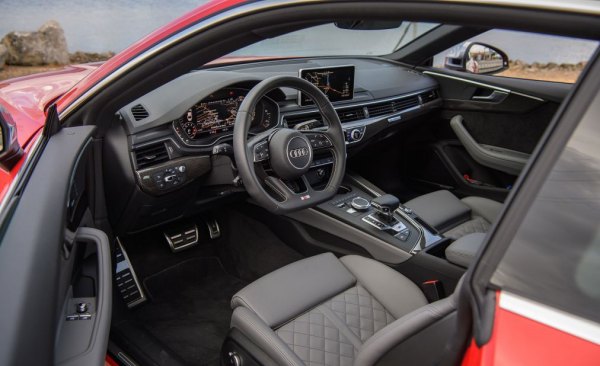 |
|
Dynamic
steering tigtens its ratio unpredictably.
|
|
Yes, the high-quality interior is attractive, but you won’t lose much
sense of occasion in a Mercedes C-class coupe. What the S5 lacks, like
its exterior design suggested, is imagination and passion. Mid-size
coupes might be an old-school breed – and its buyers are certainly
getting older – but if they look also old and conservative, how can
they lure buyers from the usual performance saloons and wagons? In this
respect, 4-Series and C-class Coupe do much better.
|
Verdict:    |
Published
on 3
Nov 2016
|
All rights reserved.
|
|
A5 / S5 Sportback
|
|
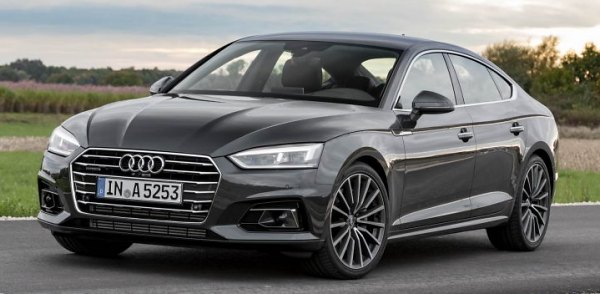 |
|
More
stylish and better built than BMW 4-Series Gran Coupe, but less so to
drive.
|
|
The idea of
“four-door coupe” was introduced by Mercedes CLS-class 12 years ago.
Since then many premium car manufacturers found it a good way to expand
their product portfolios at little cost. Audi joined the game with the
last generation A5 Sportback. It was the crossover between A4 saloon
and A5 coupe, merging the practicality of the former and the beauty of
the latter. The new A5 Sportback follows the same formula. It shares
the underpinnings of the A4, including its long, 2824 mm wheelbase,
hence proper rear-seat accommodation. Meanwhile, the lower, wider and
sportier front grille and the signature flowing waist line of the A5
coupe are carried over to the Sportback. It also sports a large
tailgate to distinguish itself from the A4 and make it easier to load
luggage. It looks quite stylish, certainly more so than the rivalling
BMW 4-Series Gran Coupe, although the front and rear end design could
be more imaginative.
The fact that the Sportback uses marginally wider tracks than the sedan
does not make a huge difference to handling. This car still drives well
in most occasions, with abundance of traction from the 40:60 Quattro
system, a tight body control from the sport mode of adaptive dampers, a
pretty responsive turn-in from the new electrical power steering and a
ride that is finally comfortable enough. That said, over sharp ridges
and sudden potholes it still transmits more shocks to your seat of the
pants than either the BMW 4-Series or Mercedes C-class, blame to the
fact that the nose-heavy nature of the Audi needs stiffer springs to
keep pitch and dive in check. The same inherent problem also robs its
steering of true communication, especially on-center. The
electronic-controlled Sport differential is supposed to introduce
torque vectoring to the rear wheels and bring some more fun, but the
effect is too subtle. This car still understeers near the limit of its
adhesion, thus power slide remains a dream. All these limitations mean
the A5 Sportback is ultimately less engaging and interesting to drive
than its BMW and Mercedes rivals.
 |
|
This
car still understeers near the limit of its adhesion, thus power slide
remains a dream...
|
|
As the engine lineup mirrors that of the A4 and A5 range, it does not
disappoint. The entry-level petrol, 2.0 TFSI engine with 252 hp
combines good power, response and refinement. The 190 hp 2.0 TDI diesel
is not bad either. Range-topping 3.0 TDI V6 is a heavy diesel engine
that could hamper turn-in response, steering feedback and ride quality
further, but the engine itself is strong, smooth, quiet and hugely
flexible. On the S5 variant, the new single-turbo 3-liter V6 is even
more powerful at 354 hp and 369 lbft of torque. Its throttle response
isn’t quite as sharp as the old supercharged V6, but everything else
trumps the latter. The 8-speed automatic gearbox it uses is smooth and
intelligent, though the S tronic twin-clutch box on less powerful
models is more responsive.
On highway, apart from the noticeable wind noise generated from door
mirrors, the cabin is extremely quiet, thanks to the 0.26 Cd as well as
good NVH suppression. The cabin itself is practically the same as A4,
with the same high-quality dashboard, high-tech “Virtual Cockpit”
instrumentation and classy switchgears that only Mercedes C-class could
be comparable. Predictably, the lower and curvier roof line robs some
headroom, so the rear seats are not designed for those taller than 6
feet. Legroom, however, is plenty, thanks to the long wheelbase. At the
back, the tailgate is electrically operated for convenience. The boot
has been enlarged slightly to 480 liters. It can be extended to 1300
liters with the rear seat folded. However, if you use it as a load
carrier, you can only pray for a shooting brake variant. No, Audi won’t
do that to damage its beautiful lines. Mercedes might.
|
Verdict:    
|
Published
on 27
Jun 2017
|
All rights reserved.
|
|
Audi RS5
|
|
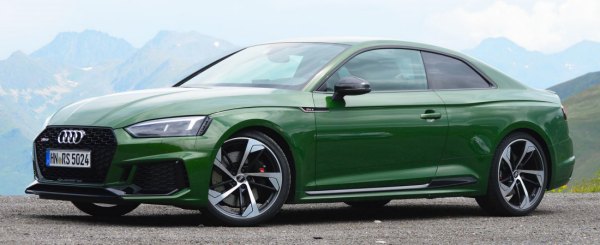
|
|
A
lot faster and greener, but not necessarily better to drive.
|
|
The last generation RS5
was hampered by its excessive mass and an inert chassis, but it had an
excellent engine and twin-clutch gearbox to save the game. Yes, the
R8-sourced 4.2-liter V8 was capable of revving to an incredible 8500
rpm and releasing 450 horsepower. Its enthusiasm for rev and emotional
sound became unique to the class when BMW M4 and Mercedes C63 Coupe
abandoned naturally aspirated V8s. Unfortunately, the new RS5 follows
the lesser S5 to turn to a turbocharged V6 – in the name of reduced
emission. Will that change put the car into an inferior position again?
Let’s see.
There are arguments who led the development of the new 90-degree
twin-turbo V6. Some said Porsche and some said Audi. Porsche introduced
it to the Panamera 4S first last year, but remember, it is based on the
single-turbo unit on the earlier Audi S4, so both stories could be true
to some extent. It goes without saying the V6 is part of the modular
V6/V8 family serving both brands as well as future Bentleys. In the
Panamera 4S, it develops 440 hp and 406 lbft of torque with a maximum
boost pressure of 1.4 bar. Audi does not reveal the turbo boost of its
own version, but I suppose it should be higher still, not just because
the engine produces 450 horsepower but the most important it makes 442
pound-foot of torque. Compared with the outgoing V8, its horsepower is
the same, while peak torque is a massive 125 lbft stronger! Moreover,
that is delivered continuously from 1900 to 5000 rpm, whereas the V8
made its peak torque from 4000 to 6000 rpm. In other words, performance
is a lot more accessible. As a result, the new car’s 0-60 mph takes
only 3.8 seconds, a huge leap from the last gen’s 4.4 seconds.
Meanwhile, top speed is still capped at 174 mph if you opt for
performance pack.

|
|
While
it is capable to rev to 6700 rpm, there is no reward to go beyond 5700
rpm because the engine has already delivered its best.
|
|
Compared with the S5 engine, the chief difference is the use of
twin-turbochargers, of course. They still sit inside the V-valley to
shorten connection, reducing turbo lag as well as speeding up warming,
hence cleaner cold-start emission. The higher boost pressure means
compression ratio has to be scaled back from the S5’s 11.2:1 to 10.0:1.
This also necessitates the stroke to be reduced from 89 to 86mm,
dropping the engine capacity to 2.9 liters. Again, to reduce fuel
consumption and carbon emission, the engine is configured to run in
Miller cycle under part load and Otto cycle for full load. The
switchover is implemented by using the second set of cam lobes of the
intake Valvelift mechanism, which enables earlier intake valve closure.
Overall, CO2 emission is cut by 17
percent from the V8. Another benefit is that the V6 is 31 kg lighter
than the V8, which relieves the burden at the nose and help taming
understeer of the old car.
In reality, the new engine does feel strong and responsive, especially
its mid-range thrust. It is easily quicker than the old car because you
don’t need to downshift or to wait for rev to pile up, but on the
flipside it feels less exciting to exploit. In fact, it feels and
sounds flat, not even the subtle pops and crackles deliberately added
on overrun can do much to negate its dull manner. While it is capable
to rev to 6700 rpm, there is no reward to go beyond 5700 rpm because
the engine has already delivered its best. That’s a huge difference
from the old V8, which might be slower but a lot more enthusiastic to
rev and to sing. Compared with rivals, AMG’s 4-liter V8 is massively
more emotional, and even the M4’s straight six sounds angrier and more
willing. Comparatively, the Audi V6 feels more like a torquey and
refined diesel.
The gearbox doesn’t help either. As the old 7-speed S tronic
twin-clutch cannot withstand the increased torque, it has to change to
the popular ZF 8-speed automatic that Audi/Porsche calls Tiptronic
(Porsche has an 8-speed PDK that will easily do the job, but it does
not fit the Quattro layout). The torque converter auto is certainly
even more refined, with seamless gearshift and hardly detectable lag,
but such a refinement actually robs it the drama brought by the more
mechanical-feeling DCT. It shifts the RS5 further away from its
fire-breathing rivals, and closer to the territory of conventional
grand tourers.
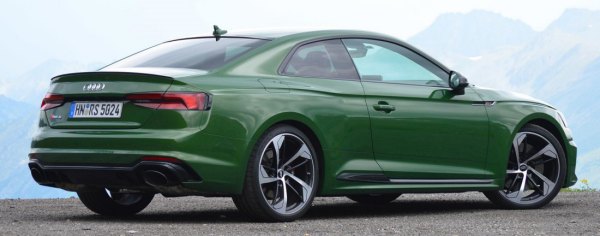 |
|
Ride
quality and agility improved, but ultimately understeer is still its
mother tongue.
|
|
The rest of the car is more predictable. Like the rest of the A5/S5
range, its lighter construction lets the RS5 undercuts its predecessor
by 70 kg, although at 1655 kg it is still nothing to be proud of. You
may save a further 3 kg by opting for a carbon-fiber roof or a dozen
kilos by specifying ceramic brakes, but they are too costly for this
class. The Quattro system uses crown-gear center differential thus its
normal torque split is 40:60 front to rear. The suspension is set 10mm
lower than that of the S5 accompanied with slightly stiffer setup. The
footwork becomes massive 275/30 rubbers on 20-inch wheels. Other cost
options include active rear differential (must have), active dynamic
steering (must not!) and Dynamic Ride Control suspension which links
diagonal wheels hydraulically to reduce pitch and roll (a worthwhile
spending, considering the Audi still has more mass at the nose than
usual cars).
On the road, the new car is noticeably more comfortable than last time.
Its ride quality is very good in Comfort mode. The cabin is quiet, very
well insulated from road and wind noise, and the engine is inherently
quiet in cruising. Select Dynamic mode and the suspension gets stiffer,
but still acceptable on normal motorways. Its GT manner is stronger
than ever.
Meanwhile, with DRC suspension it also controls its body motion
tightly. The car corners with a composed manner. Traction and grip
offered by Quattro is predictably plentiful. The steering still lacks
feel, but with a lighter nose the RS5 feels more agile to steer.
Ultimately, it runs into understeer more readily than the rear-drive M4
or C63. While its rivals can adjust attack angles with throttle, the
all-wheel-drive Audi is inert. All you can do is to back off and wait
for the understeer to diminish. Such a lack of mid-corner adjustability
means it still fails to thrill keen drivers. It might be a quicker
A-to-B car, but not the most enjoyable in the process. Coupling to a
civilized powertrain, the new RS5 is more about luxury performance than
ultimate excitement. Then again, a Mercedes E400 Coupe seems to do the
luxury thing better while looking more graceful. Does the market has
space for such a niche product?
|
Verdict:    |
|